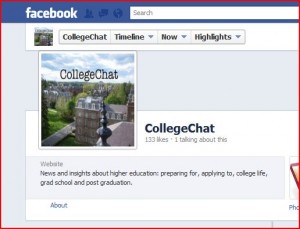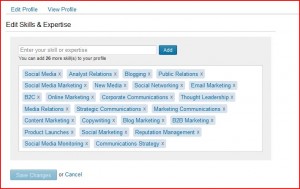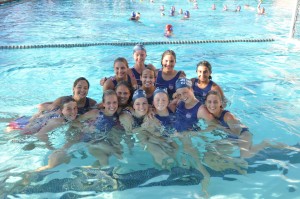Must Read: Mark Meeker’s 2014 Internet Trends
What You Need to Know About Google’s Latest Changes
Erica Moss is the author of this post and is the community manager for Georgetown University’s online masters in nursing program, offering one of the nation’s leading nurse educator programs. She enjoys blogging, TV, pop culture and tweeting @ericajmoss
 Businesses that count on their website to attract customers rise and fall on the strength of their Google ranking. Google’s recent updates to its search algorithms, the so-called Panda and Penguin changes, have had a measurable impact on the ranking of thousands of websites. Whether you have a business website or are thinking of starting one, you need to factor in the “Google Zoo” when developing your online strategy.
Businesses that count on their website to attract customers rise and fall on the strength of their Google ranking. Google’s recent updates to its search algorithms, the so-called Panda and Penguin changes, have had a measurable impact on the ranking of thousands of websites. Whether you have a business website or are thinking of starting one, you need to factor in the “Google Zoo” when developing your online strategy.
According to SEOmoz, Google developers tweak their search algorithms about 500 times per year in order to thwart spammers and ensure the quality of their search results. Most of the Google search engine changes are small, but a couple of recent updates sent traffic levels for some legitimate websites into a nosedive. No one who wants to grow their business with an online presence can afford to ignore the so-called Panda and Penguin changes. Here’s what you should know:
Panda
Released in February 2011, the Panda change penalized websites with poorly written or duplicate content. It lowered the ranking of spammy websites with high ad-to-content ratios and gave higher ranking to sites with unique, relevant and high-quality content.
Penguin
Rolled out in April 2012, this change tightened the Google search algorithm’s ability to filter out web spam techniques, like content spinning, keyword stuffing and unnatural linking. Many sites that went overboard in their use of keywords were hit by the Penguin change.
In the months following the Panda and Penguin changes, SEO experts have determined the new best practices for search engine ranking. Google also provides advice and support in the form of its Search Engine Optimization Starter Guide (available on the Google Webmaster Tools page). A few pointers include:
- Add compelling and useful content to your website in the form of articles, blog posts, forums, social media services and other means. Remove content that’s too generic or duplicated too often elsewhere.
- Attract repeat visitors with fresh, easy-to-read content that’s free from spelling and grammatical errors. Make sure your site is well organized so visitors can quickly navigate to the information they need.
- Incorporate keywords naturally into your content. They should not interrupt the flow of your website’s content or appear to be inserted after the content was written.
- Avoid unnatural anchor text. The text should tell the user something about the external page that’s being linked to from your website.
- Watch your ad-to-content ratio. First and foremost, provide your visitors with relevant content instead of hitting them over the head with advertising.
Other Considerations
In addition to considering Panda and Penguin when constructing and updating a website, it’s important to pay attention to how a website is promoted. Organic links that occur naturally when people discover your content and link to it are the best. This takes time, and Google understands that businesses need website promotion to speed up discovery of their content. Blog posts, press releases, newsletters and RSS feeds are Google-approved promotion techniques. Social media sites like Facebook and Twitter can also be used for promotion, provided the social updates aren’t too frequent. Marketing through article directories like Ezinearticles, Squidoo and HubPages, once a successful strategy for improving search engine ranking, now can hurt more than help a website.
Expert Panel to Discuss Whether Law School Is Worth the Cost on #CollegeChat September 18th
Gabrielle Lyse Brown, director of Diversity Pipeline Initiatives for the New York City Bar, and Akil Bello, owner of Bell Curves, will lead law school discussion on #CollegeChat September 18, 2012 at 9 p.m. Eastern
Amidst widespread news over the last year of unemployed and under employed law school graduates, Gabrielle Lyse Brown, director Diversity Pipeline Initiatives for the New York City Bar, and Akil Bello, owner of Bell Curves – an educational services and test preparation company, will discuss whether Law School is worth the cost on #CollegeChat September 18, 2012 at 9 p.m. Eastern.
During #CollegeChat, Brown http://twitter.com/NYCBarDiversity and Bello, http://twitter.com/akilbello , will discuss with attendees factors prospective law school students should consider before finalizing their plans to attend law school including:
- Is attending Law School amidst all the negative news regarding employment a wise choice?
- How should students weigh the potential benefits of law school against the cost of law school?
- How can students investigate the success of Law Schools in placing graduates in full time law careers?
- How much debt should law school students consider taking on?
- How should students weigh which Law School to enroll in?
- What’s the biggest mistake students make when considering what school to attend?
- Should students only consider top ranked Law Schools? What are important factors to consider?
Gabrielle Lyse Brown is the director of Diversity Pipeline Initiatives for the New York City Bar, where she leads the Association’s efforts to enhance diversity in the legal profession through developmental support for high school, college and law students of color who want to pursue a legal career. In this role, she creates, develops, and administers comprehensive programming that provides inner-city students with academic support and enrichment, professional and substantive skill development, networking/mentoring opportunities and exposure to the legal profession. She is a member of Board of Directors of Practicing Attorneys for Law Students, Inc. (PALS) and the Bronx School of Law and Finance Advisory Board.
Akil Bello is an expert in test preparation and is the owner of Educational Development for Bell Curves. Bello oversees all aspects of the development of programs and materials, as well as the training of teachers. He has worked as a teacher trainer and materials developer at three different test prep companies, bringing his unique humor and intelligence to every endeavor. After spending 15 years teaching every standardized test in the known universe, he joined his brother and father in founding Bell Curves.
About #CollegeChat
#CollegeChat is a live bi-monthly conversation intended for teens, college students, parents, and higher education experts on Twitter. #CollegeChat takes place on the first and third Tuesday of the month at 6 p.m. PT/ 9 p.m. ET. Questions for each #CollegeChat edition can be sent to Theresa Smith, the moderator of #CollegeChat via http://Twitter.com/collegechat, by entering questions online on the CollegeChat Facebook page or by email. More detailed information about signing up for Twitter and participating in #Collegechat can be found at http://pathwaypr.com/how-to-participate-in-a-twitter-chat .
Noted Social Media Scholar to Discuss How the Frequency of College Students’ Facebook Usage Correlates to Academic Engagement on #CollegeChat June 5th
Professor Rey Junco will discuss recent research on college students’ Facebook use #CollegeChat on June 5, 2012 at 9 p.m. Eastern
 Dr. Rey Junco, professor at Lock Haven University and a youth and media lab mentor at the Berkman Center for Internet & Society at Harvard University, will discuss his latest research on the relationship between Facebook use and college student engagement on #CollegeChat June 5, 2012 at 9 p.m. Eastern.
Dr. Rey Junco, professor at Lock Haven University and a youth and media lab mentor at the Berkman Center for Internet & Society at Harvard University, will discuss his latest research on the relationship between Facebook use and college student engagement on #CollegeChat June 5, 2012 at 9 p.m. Eastern.
During #CollegeChat, Junco (http://twitter.com/reyjunco) will discuss research findings from a recent study he authored “The relationship between frequency of Facebook use, participating in Facebook activities, and student engagement” with attendees including:
- Is there a relationship between frequency of Facebook use and activities and student engagement?
- Is there a relationship between frequency of Facebook use and activities and time spent preparing for class?
- Is there a relationship between frequency of Facebook use and activities and time spent in co-curricular activities?
- Why are these results important for higher education administrators, faculty and staff important?
- Why is it important for higher education to design and support interventions that meet students where they are on Facebook and other social media sites?
Rey Junco is a social media scholar who investigates the impact of social technologies on college students. Rey’s primary research interest is using quantitative methods to analyze the effects of social media on student psychosocial development, engagement, and learning. His research has also focused on informing best practices in using social technologies to enhance learning outcomes. For instance, Rey’s research has shown that technology, specifically social media like Facebook and Twitter, can be used in ways that improve engagement and academic performance. Rey has recently published papers on: the relationship between Facebook use, student engagement, and learning, the academic effects of multitasking, the digital divide in cell phone ownership and use, using social media to promote civil discourse on college campuses, and how Twitter can be used for academic purposes in order to increase student engagement and improve grades.
About #CollegeChat
#CollegeChat is a live bi-monthly conversation intended for teens, college students, parents, and higher education experts on Twitter. #CollegeChat takes place on the first and third Tuesday of the month at 6 p.m. PT/ 9 p.m. ET. Questions for each #CollegeChat edition can be sent to Theresa Smith, the moderator of #CollegeChat via http://Twitter.com/collegechat, by entering questions online on the CollegeChat Facebook page or by email. More detailed information about signing up for Twitter and participating in #Collegechat can be found at http://pathwaypr.com/how-to-participate-in-a-twitter-chat .
#CollegeChat: Public Agenda to Discuss U.S. Business Leaders Concern that Higher Ed’s Resistance to Change is Widening Skills Gap
New Research finds that U.S. Business Leaders worry that skyrocketing tuition and a growing skills gap could have serious consequences for the nation’s economic future
 Allison Rizzolo, a communications professional for Public Agenda, a nonpartisan, nonprofit organization that helps communities and the nation solve tough public problems, will discuss findings from a recent report “Hiring and Higher Education” conducted in conjunction with Committee for Economic Development (CED), during #CollegeChat on Twitter, April 17, 2012 at 9 p.m. Eastern.
Allison Rizzolo, a communications professional for Public Agenda, a nonpartisan, nonprofit organization that helps communities and the nation solve tough public problems, will discuss findings from a recent report “Hiring and Higher Education” conducted in conjunction with Committee for Economic Development (CED), during #CollegeChat on Twitter, April 17, 2012 at 9 p.m. Eastern.
THE CED and Public Agenda undertook this research “to explore the attitudes of business leaders toward higher education.” Rizzolo, https://twitter.com/#!/publicagenda , will discuss key findings from the report with #CollegeChat participants including:
- Cost of higher education is a major concern. The business leaders interviewed described the escalating cost as one of the major weaknesses of higher education.
- Shortage of graduates in STEM fields. The report found that business leaders cited a serious shortage in science, technology, engineering and math.
- Unease about workers’ interpersonal skills. Business leaders were uneasy about graduates’ lack of basic interpersonal skills. Executives complained about the character, interpersonal skills and comportment of young people they encountered.
- Resistance to change. Business leaders worried that higher education is too slow to recognize and implement needed changes, and not as accountable as it needs to be.
About Public Agenda
Public Agenda is a nonpartisan, nonprofit organization that helps communities and the nation solve tough public problems. It does this by illuminating people’s views and values, getting them working together on solutions, and building momentum for change. Public Agenda is fostering progress on a wide variety of critical issues, including K-12 and higher education, climate change and health care. Its goal is to contribute to a democracy in which problem solving triumphs over gridlock and inertia, and where public policy reflects the deliberations and values of the citizenry.
About #CollegeChat
#CollegeChat is a live bi-monthly conversation intended for teens, college students, parents, and higher education experts on Twitter. #CollegeChat takes place on the first and third Tuesday of the month at 6 p.m. PT/ 9 p.m. ET. Questions for each #CollegeChat edition can be sent to Theresa Smith, the moderator of #CollegeChat via http://Twitter.com/collegechat , by entering questions online on the CollegeChat Facebook page at http://ht.ly/1XIqV , or by email. More detailed information about signing up for Twitter and participating in #Collegechat can be found at http://pathwaypr.com/how-to-participate-in-a-twitter-chat .
SAT and ACT Test Expert to Discuss Test Accommodations and Preparation for ADD/ADHD High School Students during #CollegeChat
Jenn Cohen, college test preparation expert and owner of Jenn Cohen Tutoring, will provide tips for ADD/ADHD high school students to maximize their PSAT, SAT, and ACT scores during #CollegeChat April 3, 2012 at 9 p.m. Eastern
Jenn Cohen, a college test preparation expert for the SAT, PSAT and ACT, specializing in ADD/ADHD and special needs students, will discuss how high school students with ADD/ADHD and other learning disabilities, can maximize their college admission testing scores by carefully researching test accommodations and creating and implementing an effective test preparation plan during #CollegeChat on Twitter, April 3, 2012 at 9 p.m. Eastern.
Cohen, https://twitter.com/#!/satprepforadhd, the owner and founder of Jenn Cohen Tutoring and president of chief word nerd of Word-Nerd.com, an SAT vocabulary website, will discuss with #CollegeChat participants:
- What kind of test accommodations is available for high school students with ADD/ADHD or other learning disabilities?
- How do students research what test accommodations are available? How far in advance should they research?
- How should students determine which is the best test for them?
- Why might the ACT be a smarter choice for ADHD students?
- How far in advance should an ADD/ADHD student plan to prepare for college admission tests?
- Ideally, when should students take the first test and how many times do you recommend?
- If a student can’t afford tutoring services, how do you recommend they construct a test preparation plan?
- Are there websites you recommend for test preparation? Are there apps you recommend?
- Are there specific SAT and ACT test preparation books for students with ADD/ADHD you recommend?
Jenn Cohen has been in test prep since 1997 and has been a private tutor for the SAT and PSAT, specializing in ADHD/learning disability students. Cohen is also president of Word-Nerd.com, an SAT vocabulary tutorial website which she created with her husband, Gary. Cohen has a blog, The Fat Envelope, which covers all things college admissions. A Duke University graduate, Cohen currently serves on the alumni admissions interviewing committee as well as the Duke Dallas Women’s Forum steering committee. Cohen’s graduate work in clinical psychology at the University of Texas Southwestern Medical Center provided her with extensive knowledge of attention deficit and learning disorders.
About #CollegeChat
#CollegeChat is a live bi-monthly conversation intended for teens, college students, parents, and higher education experts on Twitter. #CollegeChat takes place on the first and third Tuesday of the month at 6 p.m. PT/ 9 p.m. ET. Questions for each #CollegeChat edition can be sent to Theresa Smith, the moderator of #CollegeChat via http://Twitter.com/collegechat , by entering questions online on the CollegeChat Facebook page at http://ht.ly/1XIqV , or by email. More detailed information about signing up for Twitter and participating in #Collegechat can be found at http://pathwaypr.com/how-to-participate-in-a-twitter-chat .








